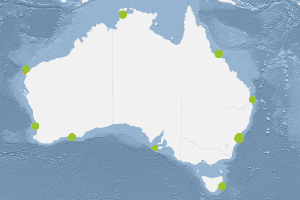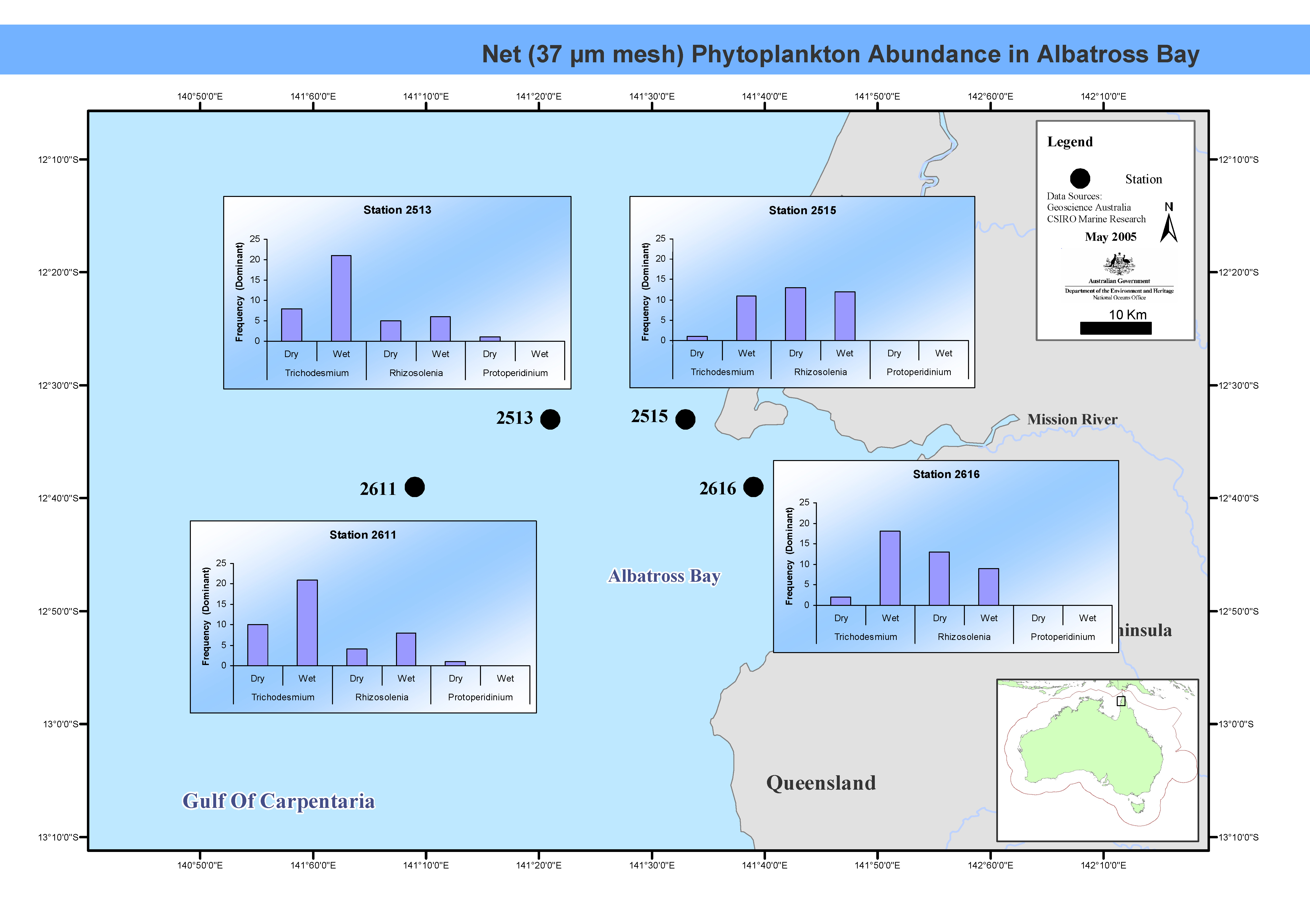Keyword
Earth Science | Biological Classification | Protists | Diatoms
17 record(s)
Type of resources
Topics
Keywords
Contact for the resource
Provided by
Formats
Update frequencies
Status
draft
-

This dataset comprises the phytoplankton abundance and biovolume estimates as part of a broader sampling program carried out at the Southern Ocean Time Series, a facility within the Integrated Marine Observing System (IMOS). The primary focus is sustained observing of ocean properties and processes important to climate, carbon cycling, and ocean productivity. Regular phytoplankton samples are collected at approximately 14 day intervals (exact intervals and seasonal coverage dependent on deployment length). The moorings are serviced annually, at which time the existing moorings are recovered and new moorings are deployed. Water samples from within the surface mixed-layer are collected at pre-programmed intervals using a Remote Access Sampler, in pairs about 1 hour apart. One sample in each pair is preserved for phytoplankton community composition by microscopy, and the other sample is preserved and used for accompanying chemical analysis of nutrients, total dissolved inorganic carbon (DIC) and alkalinity. Each sample is collected from within the surface mixed-layer at 32 m depth (2010 - 2017) or 5 m depth (2018-current) depending on the design of the mooring surface assembly and instrumentation. Typically a maximum of 24 samples are collected over an annual deployment cycle. The samples collected are analysed for: 1. Community composition / abundance (cells/L) 2. calculated biovolume (um3/L). Protocols for the phytoplankton time-series are described in Eriksen et al (2018), and the annual sample reports for each deployment. Data storage and access is planned to be interoperable with other national and international programs through the IMOS Infrastructure. Station metadata can be found through this resource. Data is available freely via the AODN portal: https://portal.aodn.org.au. As the taxonomic resolution of the data has changed over time, due to continual training, it is important that users refer to the change log tables included in your data download. These will provide information on the validity of the taxa, from what date we have been identifying certain taxa etc. Classification fields may be blank depending on the level to which that taxa has been identified, i.e. if only identified to family, genus and species will be blank.
-

This map shows phytoplankton abundance in Albatross Bay. The biomass and species composition of tropical phytoplankton in Albatross Bay, Gulf of Carpentaria, northern Australia, were examined monthly for six years between March 1986 and April 1992. Phytoplankton taxonomic groups were identified to genus level, and described as dominant, common or rare. This map has been produced by CSIRO for the National Oceans Office, as part of an ongoing commitment to natural resource planning and management through the 'National Marine Bioregionalisation' project.
-
This record is an overview entry for biological data collected on Diamantina cruise Dm 1/60. This cruise took place in the Indian Ocean off the coast of Western Australian and in the Great Australian Bight during 2 February - 23 March 1960, under the leadership of A. Crooks & R. Davies. Biological data collected on this cruise include occurrence of diatoms and dinoflagellates from phytoplankton sampling stations. Zooplankton biomass from 200 m to the surface and 400 m to 200 m. Primary production rates from each 14 C station. Please note: This metadata record is a preliminary entry derived from information in the cruise report. Individual data types - which may span several cruises - will be indexed separately within this metadata system in due course.
-
This record is an overview entry for biological data collected on Diamantina cruise Dm 3/61. This cruise took place in the northeast Indian Ocean and the Timor Sea during 20 July to 26 August 1961, under the leadership of D. Tranter & J. MacIntyre. Biological data collected on this cruise include primary production rates; organisms with/without chlorophyll, total particles and occurrence of diatoms and dinoflagellates from phytoplankton stations; pigment samples; and zooplankton biomass. Data on seston, enrichment experiments and transparency recordings were also obtained. Please note: This metadata record is a preliminary entry derived from information in the cruise report. Individual data types - which may span several cruises - will be indexed separately within this metadata system in due course.
-
This record is an overview entry for biological data collected on Diamantina cruise Dm 2/61. This cruise took place in the Indian Ocean, Timor and Java Seas during 1 May to 12 June 1961, under the leadership of B. Newell. Biological data collected on this cruise include primary production rates; organisms with/without chlorophyll, total particles and occurrence of diatoms and dinoflagellates from phytoplankton stations; pigment samples; and zooplankton biomass. Please note: This metadata record is a preliminary entry derived from information in the cruise report. Individual data types - which may span several cruises - will be indexed separately within this metadata system in due course.
-
This record is an overview entry for biological data collected on Diamantina cruise Dm 1/61. This cruise took place in the Indian Ocean and the Great Australian Bight during 14 February to 10 March 1961, under the leadership of D. Rochford & D. Tranter. Biological data collected on this cruise include primary production rates from each 14 C station; organisms with/without chlorophyll, total particles and occurrence of diatoms and dinoflagellates from phytoplankton stations; pigment samples; and zooplankton biomass. Please note: This metadata record is a preliminary entry derived from information in the cruise report. Individual data types - which may span several cruises - will be indexed separately within this metadata system in due course.
-
This record is an overview entry for biological data collected on Diamantina cruise Dm 2/59. This cruise took place in the east Indian Ocean during 11 October - 19 November 1959, under the leadership of D. Rochford and A. Crooks. Biological data collected on this cruise include occurrence of diatoms and dinoflagellates from phytoplankton sampling stations. Zooplankton biomass from in the upper 200 m. Primary production rates from each 14 C station. Please note: This metadata record is a preliminary entry derived from information in the cruise report. Individual data types - which may span several cruises - will be indexed separately within this metadata system in due course.
-
This dataset contains the results from algal bloom surveys in the Swan River, Perth, Western Australia. Aeroplane flights were used to map the extent of the blooms and at the same time, sea truthing of the images were made using an analysis for various pigments and obtaining phytoplankton samples. Four flight periods were made between October 1994 and December 1995, with up to 4 flights a day. The main species studied was the dinoflagellate Gymnodinium.
-
This dataset comprises hydrological and plankton data collected on Derwent Hunter Voyage DH 6/56 in the Tasman Sea, between December 1956 and February 1957. The dataset contains measurements of temperature, chlorinity, dissolved oxygen and total phosphorus at 20 stations in vertical sections to maximum depths ranging from 200 to 1500m, surface wind data, comments on zooplankton species composition and abundance (copepods and salps) studied at 12 stations, and phytoplankton (diatoms and dinoflagellates) from 11 stations. There are also brief comments about tuna catches. The hydrology data are published in CSIRO's "Oceanographical Station List" series, and discussed in Division of Fisheries & Oceanography Report no. 12, where the cruise track and the biological data are given.
-
The biomass and species composition of tropical phytoplankton in Albatross Bay, Gulf of Carpentaria, northern Australia, were examined monthly for six years between March 1986 and April 1992. Phytoplankton taxonomic groups were identified to genus level, and described as dominant, common or rare. Refer to the cited publication for detailed methodology.
